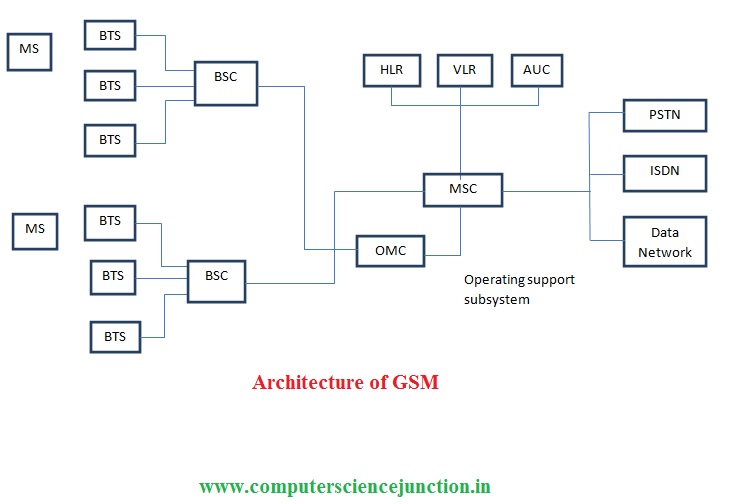GSM full form based questions are asked in exam. In this tutorial we have discussed Basics of GSM.
Table of Contents
GSM Full Form and Architecture
- GSM is a international standard for Digital Cellular Communication.
- GSM and CDMA are are two types of mobile systems available.
- GSM is established by European Telecommunication Standards Institute (ETSI).
- GSM is a protocol defined for 2 G network.
- GSM and CDMA are are two types of mobile systems available.
Here we will briefly discuss about GSM full form and GSM architecture.
Full form of GSM
Full form of GSM is Global System for Mobile Communication. GSM is a big system comprised of some small systems such as-
- Mobile Station (MS).
- Base Station Subsystem (BSS).
- Network and Switching Subsystem (NSS).
- Operating Subsystem (OSS).
Characteristics of GSM
There are following characteristics of GSM
- GSM use Narrow band Time division multiple access methods for Signal Transmission.
- GSM use Circuit Switching Concepts.
- GSM operate on mobile communication band at frequency of 900 MHZ and 1800 MHZ.
Advantages of GSM
Some advantages of using GSM are given below –
- Duplicate service is very difficult because all the data is stored on the sim so GSM is secure.
- GSM also supports different types of applications.
- GSM provides simultaneous use of voice and data.
- Clarity of voice service is very good.
GSM Architecture or Components of GSM
The architecture of GSM is shown in following picture. Various components of GSM are as shown in the picture given below –

- MS here is the mobile station which is nothing but the device used for mobile communication, such as cell phone, fax machine etc.
- BSS means Base Station Subsystem which gets connected to MS via radio interface.
- It has two different blocks such as BTS (Base transceiver system).and BSC (Base station controller).
- Every MS gets connected to BTS of that area.
- BTS sends signal to BSC.
- Many BTS are connected to one BSC and at the end of this BSC is connected to MSC.
- Hence BTS system consists of BTS and BSC.
- NSS means Network and Switching Subsystem which mainly contains MSC. MSC is the backbone of the entire network operations.
- It controls all the operations from setting up a call to the handoff procedure.
Blocks of Network Switching System ( NSS)
Some important blocks of NSS are as follow –
HLR (Home Location Register)
- Home Location Register keeps the database of all the users who reside in the same geographical area.
- HLR is an integrated part of GSM.
- HLR contains user information including address, account status and preferences.
- HLR interacts with mobile switching center which is used for for call control and processing.
VLR (Visitor location register)
- Visitor Location Register keeps the track of all the visitors for that particular geographical area, i.e. the roaming customers.
- VLR support roaming function for users out side the coverage area of their own HLR.
AUC (Authentication Centre)
- Authentication Center mainly controls the authentication of the users by checking their SIM numbers etc. and sends the required information to MSC.
- AUC validates any security information management card attempting network connection when a phone has a live network signal.
Disadvantages of GSM
Some disadvantages of GSM are as follow –
- Transmission can be interfere because many bandwidth is shared among multiple users.
- GSM can disrupt the electronic device because it use pulse transmission technology.
- GSM is a complex system
Conclusion and Summary
GSM Full Form and GSM architecture is explained in this tutorial. I hope this tutorial will be beneficial to students. If you have any query related to GSM then you may ask in comment section.


